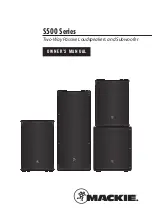
frameless
the same wire which is hooked to the positive terminal of the
amplifier has its other end hooked to the positive terminal of
the speaker. It is important to check this on all speakers. If the
connections on one of the speakers are reversed, (out of phase)
the quality of your bass will be seriously impaired.
INSTALLATION
If the speaker locations have not yet been established then do
so now. Assess the ceiling or wall area for possible concealed
obstructions such as wiring, plumbing, heating ducts, etc. For
the ceiling this is best done through an attic crawl space if
available. Absence of a crawl space will require greater study of
observable clues and may possibly require the use of inspection
holes and inspection tools (camera, mirror, flashlight, etc.). Use
a “stud finder” to locate the positions of the joists or studs. We
recommend that the edge of the speaker holes be at least ¾"
(19mm) away from joists or studs whenever possible to allow
clearance for the toggle clamps.
Once the speaker locations are established use the cardboard
template (the outside of the inner cardboard disk) or the plastic
compass provided with your speaker to draw the speaker cut-out.
The hole diameters for the various speakers are marked on the
compass. The cardboard templates may also be used as a visual
aid for placement of the speakers. Temporarily hold the templates
in place with a push tack or tape.
Using the proper tool, cut the appropriate
sized hole in the wall. On drywall, clean cuts
can be made with a drywall saw. Cut the
hole to the inside of the drawn circle.
If the cable has not yet been run, do so now
that you have access to the ceiling or wall's
interior. Once the speaker cable has been
run, pull the end of the cable out of the speaker cut-out, strip back
a section of the jacket as needed, and then expose ½" (13mm) of
each conductor.
To aid in speaker performance, a fibrous material, such as
fiberglass or polyester fiber, may be placed behind the speaker.
This may also help to reduce unwanted sound from being
transmitted into adjoining rooms. If the ceiling space has blown
or loose insulation, it is important to prevent the insulation from
entering the back of the speaker. This can be accomplished by
placing a batt of fiberglass insulation,
fabric barrier, or bag over the back of
the speaker. Alternatively you may
use an
Insu-Flate ISF-147,
which is
an acoustically transparent fabric
cover specifically designed for this
application. Placing a rigid enclosure
behind the speakers can be done
but the enclosure should be large enough not to degrade the
performance of the speaker. Rigid enclosures of less than 0.75
cuft (21 liters) should be stuffed with acoustic insulation such as
fiberglass.
As the drawing shows, the speakers utilize Toggle Clamps which,
after tightening, hold the speakers in place. Ensure that the toggle
clamps are rotated into their “Home” position. This way, they will
clear the edge of the cut-out.
Verify that the speaker fits properly into the cut-out. If the hole
should have been cut a little too large the flange on the speaker
should cover this. Remove the speaker from the hole.
Connect the wire conductors to the terminals on the back of the
speaker by depressing each spring terminal, inserting the wire
into the hole, and releasing the terminal. Use care to observe the
proper polarity (+ & -). Speakers wired out of phase will exhibit an
apparent loss of bass response.
Note:
Single-Point speakers
have both the left and right channel
connections on the same speaker. Ensure that both channels are
connected and in phase. An out of phase connection to a single-
point speaker will be immediately obvious when signal is applied
since there will be little if any bass output. If disconnecting one
of the inputs increases the bass output then the inputs are out of
phase.
Insert the speaker into the hole and
tighten the four toggle screws. As you
start to turn each screw the toggle
clamps will rotate outward to engage
the ceiling or wall material as shown.
CAUTION: DO NOT OVER-TIGHTEN THE
CLAMPS. Too much torque may damage
the toggle, causing the speaker not to
seat securely. A snug fit is all that is
necessary to assure proper performance.
The grilles can be painted using multiple light coats of paint.
Certain paints will require thinning to avoid clogging the grille’s
perforations. It is not necessary or recommended to remove the
scrim cloth from the back of the grille prior to painting.
If your speaker includes a pivoting tweeter aiming it toward the
listening area will raise the amplitude of the highest frequencies
(>12kHz), adding brilliance. USE CARE TO AVOID DAMAGING THE
DOME OF THE TWEETER WHEN AIMING!
Attach the grilles to the speakers and enjoy. Should you wish
to remove the grilles from the speakers pull at the grilles' edge.
Initially there will be a significant resistance because the grilles
are magnetically attached.
ISF-147
page 2 of 2
Install Guide
Rev. E
frameless
For: 6-1/2"& 8"
In-Ceiling
Tighten 4
Phillips screws
RO
TA
TE
Home




















